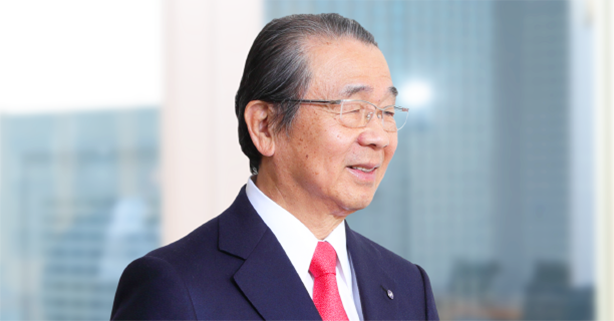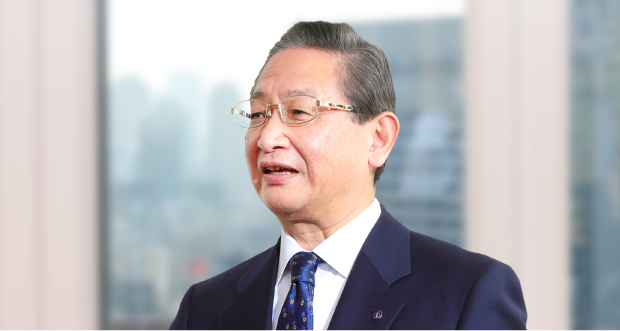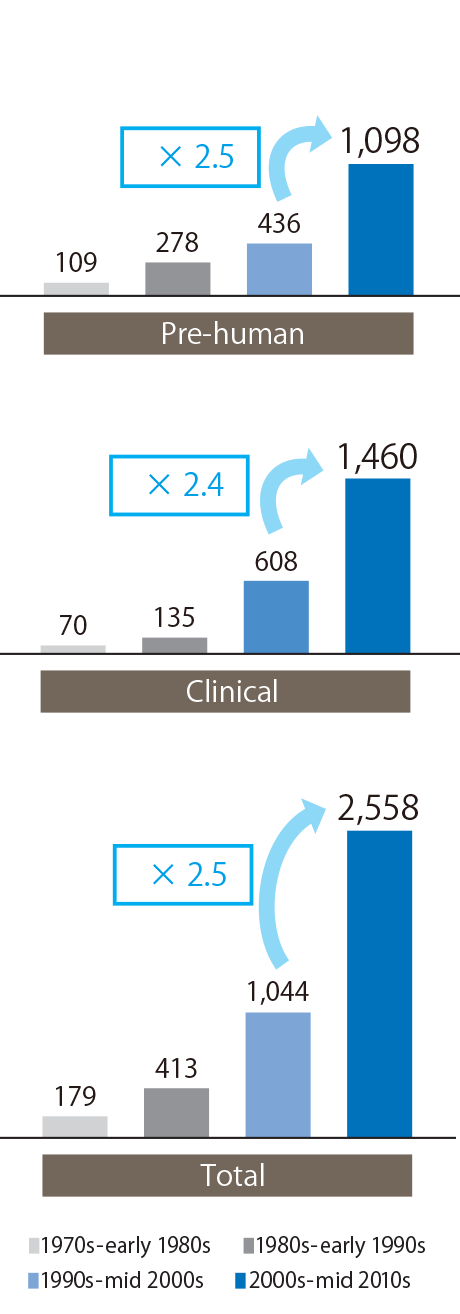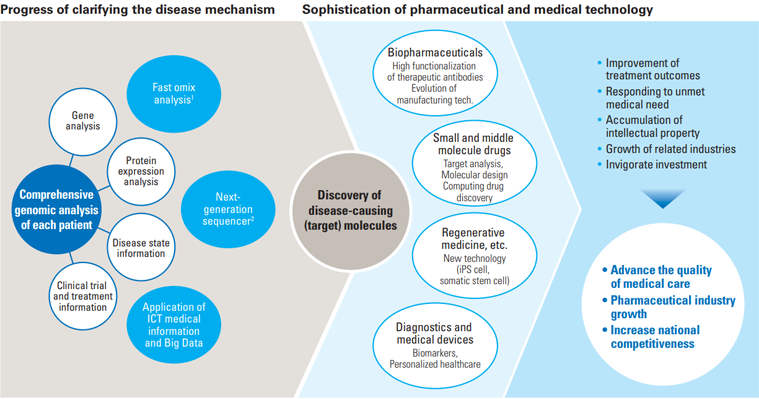Message from the CEO (Discussion)
Chugai appointed a new CEO on March 22, 2018. In this section, Representative Director & Chairman Osamu Nagayama, who served as CEO until that date, and Representative Director & President Tatsuro Kosaka, the newly appointed CEO, share their thoughts with stakeholders.
Representative Director & Chairman
Osamu NagayamaRepresentative Director & President CEO
Tatsuro KosakaChugai appointed a new CEO on March 22, 2018. In this section, Representative Director & Chairman Osamu Nagayama, who served as CEO until that date, and Representative Director & President Tatsuro Kosaka, the newly appointed CEO, share their thoughts with stakeholders.
We constantly transform ourselves to deliver innovative pharmaceuticals.
yama
Continuously bringing innovative drugs to patients suffering from disease is Chugai's purpose.
Chugai was founded in 1925 in response to the severe shortage of medicine after the Great Kanto Earthquake, and the Company's commitment to contributing to healthcare with exceptional medicines has not changed since then. To live up to the Company's founding spirit, we constantly transform ourselves to adapt to the needs of the times and society. I believe this is the reason we have continued to grow.
Chugai's business model has certainly changed a great deal during its history of more than 90 years. In response to changes in social and business conditions, the Company switched its primary business focus from over-the-counter drugs to prescription drugs, and ventured into biopharmaceuticals ahead of its industry peers. We have never been afraid to change or to take risks.
The turning point that laid the foundation for our current business model was the strategic alliance we began with Roche in 2002. I conducted negotiations for the alliance as head of the working group under your supervision, but I was deeply aware of how significant it would be for the medicines that Chugai creates to contribute to healthcare globally.
yama
Diseases have no borders. Chugai exists to create innovative drugs that address unmet medical need,1 but unless we deliver value to patients worldwide, we cannot fulfill that role. And there are limits to how much of the enormous cost associated with creating new drugs can be covered by a single company. The formation of this unique alliance, in which we are a member of Roche Group but still maintain our stock listing and management autonomy in Japan, was a decision we made in order to continue pursuing innovation independently as an R&D-driven company.
In 2017, the fifteenth anniversary of the alliance, Chugai's revenues and operating profit have more than tripled and our market capitalization has grown about 9 times2 compared with their levels before the partnership. I see this as proof of the value of the business model we established through the alliance.
1. Medical need that is not adequately met due to a lack of effective treatments
2. As of December 31, 2017

so Chugai has to deliver value globally. We will enhance our corporate value by continuing to innovate for the benefit of patients around the world.
Osamu Nagayama
Creating a unique business model enabled global growth.
I agree. At the party held when the alliance was formed, someone said in a speech that “Chugai has become a global company overnight,” and that really is true.
These last 15 years can be divided into three periods. In the first phase up to 2008, we were busy bringing the management of the “New Chugai” up to a global level. We carried out clinical development, regulatory filings and launches of multiple large projects simultaneously to make the products sold by Roche worldwide available in the Japanese market, which was an unprecedented challenge for us. At the same time, we introduced a project lifecycle management system and a Specialty MR system, carried out business process reengineering, and made other enhancements in anticipation of business scale expansion.
With the establishment of this business foundation during this phase, we were ready to step up our efforts in the second phase from 2009 to 2014 toward becoming a “top pharmaceutical company”.
yama
In 2009, we set our fundamental goal of becoming a top pharmaceutical company, backed by the growth of our employees.
The source of corporate value is people. The quality and volume of the global-level work our people experienced following the start of the alliance in 2002 significantly boosted their professional development. We had already established top positions in oncology and antibody research, but the awareness of our employees had not kept pace with the rapid expansion of our business in certain aspects.
Our next task was to instill in employees a mindset of setting ambitious goals for themselves rather than following other companies, and working with pride and awareness as an industry leader. That's why we set the goal of becoming a top pharmaceutical company.
We laid out a clear vision and encouraged the autonomous change of individual employees, which helped to raise the level of our subsequent activities. I think this prepared us to deliver unprecedented value to patients and the medical community in all our functions as a leading company, in ways such as continuous generation of innovative projects, promotion of personalized healthcare, and enhancement of safety management.
That brings us to the third phase from 2015 to the present. The goal of becoming a top pharmaceutical company is now well established among our employees, and we are taking on the challenge of new fields on our own through acquisition and implementation of competitiveness at a top global level. Mid-term business plan IBI 18, which incorporates our message of “Innovation beyond Imagination,” is a management plan for taking on unprecedented challenges.
yama
When I look back at our growth since the start of the alliance, I think it has been driven by our pursuit of innovation in every aspect of our business and by Chugai's unique earnings structure.
Chugai has two growth engines. One is the products we in-license from Roche. Exclusively selling the Roche Group's groundbreaking therapies in Japan provides a stable revenue base. That stability has allowed us to tackle more challenging and innovative projects in our own research activities, our second growth engine. The innovative products resulting from that research are sold in the global market through the Roche Group. This is a revenue base that drives growth, and provides the capital for pursuing further innovation.
Definition of a “Top Pharmaceutical Company”
(The company Chugai aims to become by the late 2010s)
A company that focuses on first-in-class1 and best-in-class2 products and services,
and continuously provides new solutions to patients and medical communities around the world.
— Innovation all for the patients —
1. An original drug that is highly novel and useful, and will significantly change the therapeutic system
2. A drug that offers clear advantages over other existing drugs in the same category, such as those with the same molecular target
Quantitative Aspects
1. Among the top three Japanese pharmaceutical companies in the following:
- Domestic market share
- Ratio of consolidated operating profit to revenues
- Consolidated operating profit per employee
- Domestic sales per medical representative
2. No. 1 presence in strategic disease areas
- Oncology/Renal/Bone & Joint/RA: Top-class sales share and stakeholder satisfaction
- Establishment of top brand in hospital market by supporting medical liaison networks between medical professionals
3. Expansion of global presence
- Higher overseas sales ratio
- Number of large global products in lineup
- Number of global projects in late-stage development
- Continuous addition of first-in-class and best-in-class in-house projects to the portfolio
Qualitative Aspects
1. A company that satisfies all its stakeholders and receives their active support and trust
2. A company that works proactively on a global level
- Continuous creation, development, and domestic and overseas launches of products with a competitive advantage in clinical results
- Contribution to the Roche Group's results through product-appropriate fostering and sales
- Leadership in pharmaceutical industry activities
- Activities in which all employees have an awareness, sense of responsibility and pride as part of a top pharmaceutical company
Industry-leading discovery capabilities lead to major value creation.
yama
Chugai's drug discovery capabilities are also an important growth engine for the Roche Group. Actemra and Alecensa, which were both discovered by Chugai, are being brought to patients around the world through Roche, and are contributing to the Roche Group's earnings. The fact that five3 of the Roche Group's 193 breakthrough therapy designations (BTDs)4 were for projects originating from Chugai research indicates the high level of our innovation capabilities.
Chugai was one of the first companies in Japan to begin discovery research using biotechnology and has established a world-leading technological platform, including antibody engineering technologies. The therapeutic antibodies and other drug candidates we discovered are now entering the clinical stage of development one after another. We are also working on creating middle molecule drugs as our next-generation technology in pursuit of value creation driven by advanced science and technology.
In 2017, the second year of IBI 18, our strengths began to yield real results. As such, it was a pivotal year for us. In terms of financial performance, we achieved record revenues and operating profit, and the quantitative and qualitative objectives we set for becoming a top pharmaceutical company are now within reach.
In terms of strategy, Hemlibra, a product from Chugai research that promises to be one of our most important growth drivers, was launched first in the United States for hemophilia A with inhibitors, following simultaneous regulatory filings in Japan, the United States and Europe. This is a very significant achievement. Hemlibra is an innovative drug that was discovered using Chugai's proprietary bispecific antibody technology, and we were able to carry out rapid global development and a quick market launch through the Roche Group's network. It is thus a project that exemplifies the strength of our business model. As a drug that brings innovation to hemophilia treatment, Hemlibra is expected to offer significant benefit to patients worldwide. We also steadily advanced our priority agenda, including the smooth development progress of Tecentriq, another key growth driver, the establishment of a biological API production system to handle high-mix, low-volume production, and the development of a new system for providing solutions based on cooperation among the Marketing & Sales, Medical Affairs and Drug Safety divisions.
In 2018, the final year of IBI 18, the market environment is expected to pose challenges, such as the biannual NHI drug price revisions. However, we are committed to successfully completing our strategies in all functions – discovery, clinical development, manufacturing and solution provision – and adding to our accomplishments to wrap up our efforts during the three years of the plan.
3. As of February 1, 2018
4. A system introduced in July 2012 by the U.S. Food and Drug Administration aimed at expediting the development and review of drugs for the treatment of severe or life-threatening diseases or symptoms

the healthcare industry, our people
will be the key to benefiting patients.
Backed by their talents, we will
pursue innovation to achieve growth
in the medium to long term.
Tatsuro Kosaka
The only response to structural changes in the industry is to pursue innovation.
As we go forward, disruptive technologies such as artificial intelligence, the Internet of Things and nanotechnology are expected to bring about what has been described as the Fourth Industrial Revolution. In addition, there are threats to sustainability, including declining birth rates, aging populations, environmental degradation, and ballooning public debt. The interaction between these issues is likely to usher in a period of dramatic change unlike any we have ever experienced. In the healthcare industry, although new medical technologies are expected to generate new demand, competition is sure to intensify with the entry of players from other industries, and the global rise in social security costs and weakening fiscal positions will inevitably lead to further measures to control healthcare costs.
In order to continue creating value going forward, Chugai has to make the most of its strengths and prepare for the coming changes in the industry structure. The only way to do this is by pursuing innovation.
yama
Chugai's driving force truly is innovation. On the other hand, innovation – that is, the creation of novel medicines – is becoming increasingly difficult. Global competition to develop new drugs has intensified as the difficulty of development rises and technological advances drive up costs. According to one study,5 successfully developing a new drug and bringing it to market requires investment of as much as U.S.$2.5 billion (roughly ¥300 billion), including the cost of projects that quietly fail. It is hard for a pharmaceutical company to grow and survive without the financial strength to shoulder that burden.
However, drug development is highly specialized by nature, so the risks associated with the business, the process of innovating, and the various technologies and amount of investment required are not well understood by the public. Unless innovation is properly valued, pharmaceutical companies cannot create breakthrough drugs to cure diseases that have no existing treatments. Life science, which includes the pharmaceutical industry, is a field that uses precise and advanced science and technology. It will continue to be a growth sector in the global industrial structure.
Drug Development Cost over Time
(Results of a Study by the Tufts Center for the Study of Drug Development) (Millions of USD)


The pharmaceutical industry as a whole should be engaging in a discussion on health economics and the balance between innovation and cost. As a leader in the industry, Chugai should do what it can to encourage such debate.
In addition, while we have grown on the strength of our unique business model and technologies, there is no guarantee that this growth will continue indefinitely. As I said earlier, technological innovation with the potential to transform society is advancing. To continue innovating, we must think beyond the conventional framework of drug discovery.
In this context, while realizing advanced pharmaceutical treatments in our core realm of “the pill,” we must expand our efforts “around and beyond the pill,” in other words, beyond the borders of the pharmaceutical industry. In the realm of the pill, we will continuously produce innovative medicines by leveraging our existing strengths as well as middle molecule discovery technology – our next-generation core technology – and open innovation6 that includes cutting-edge immunology research through a comprehensive alliance with IFReC.7 Around the pill, in the realm of solutions bordering on medicines, we will start offering a genomic testing service that uses a next-generation sequencer in the business with Foundation Medicine Inc. (FMI) that we will launch on a full scale in 2018. We want to take advantage of the synergy of this service with the pharmaceutical business so that we can contribute to the advancement of personalized healthcare and genomic medicine. Beyond the pill, in fields beyond medicines, we intend to work toward greater innovation in various ways including through collaboration with partners in other industries while harnessing the so-called Fourth Industrial Revolution as an opportunity for innovation. Led by the Science & Technology Intelligence Department established in April 2017, we plan to link these efforts to a growth scenario as our first initiative.
The next mid-term business plan is currently being drawn up. We intend to disclose the specifics of our growth strategy when the plan is announced.
5. In a study by the Tufts Center for the Study of Drug Development (see graph above), it was estimated that development of a single drug requires investment of approximately U.S.$2.5 billion (approximately ¥300 billion) based on the clinical development success rate.
6. Generating innovative, new value by utilizing the technologies and development capabilities of external research networks in addition to in-house capabilities.
7. Osaka University Immunology Frontier Research Center
Clarification of Disease Mechanisms and the Advancement of Emerging Drug Discovery Technologies

1. Comprehensive analysis, recording and use of in vivo DNA, protein and other molecules
2. A device that is capable of sequencing genomes at high speed
Under the new CEO structure, we will aim for continuous innovation and greater corporate value.
yama
The year 2017 was very significant for Chugai. The initiatives we have taken began to yield results; we marked the fifteenth anniversary of the alliance with Roche; and, for me, it was the twenty-fifth year since I was first appointed President. Now, 2018 will be the year we prepare the next mid-term business plan as we approach our goal of becoming a top pharmaceutical company. I thought the timing was right to pass the baton to a new CEO, and Mr. Kosaka accepted. I will focus on supervising management as Representative Director & Chairman so that Chugai creates value befitting a top pharmaceutical company, including value from an environmental, social and governance (ESG) perspective.
When I heard that I was going to be named the new CEO, I was very surprised, but I also felt a tremendous sense of responsibility and motivation.
As you said, our people are the key to pursuing innovation for the benefit of patients. Under IBI 18, I made a commitment to revamp our human resource strategy and talent management system to develop the next generation of managers. We have identified seven global competencies as the parameters for the type of people we seek, and by linking productivity, diversity and work-life synergy, we intend to be a company where talented people have the freedom to reach their full potential. I will place the highest importance on fostering an energetic, enjoyable and positive corporate culture because I believe such a culture is fertile ground for nurturing the seeds of innovation.
With people as its greatest asset, Chugai will further increase its corporate value by continuing to innovate. You can expect great things from Chugai as we move forward.